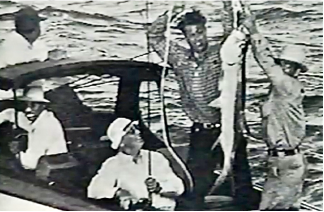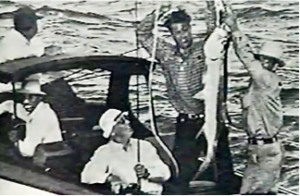
Atlantic Conference With Winston Churchill The Foundation for the United Nations – August 1941
USS POTOMAC MINI-HISTORY
BY WALTER ABERNATHY
This presidential yacht, off the coast of New England for some relaxation and to escape the Washingtonheat and humidity. It was expected to be the usual fishing routine on the Potomac with the traditionaldaily betting contests for first, biggest, and most fish.
But on this trip the fish would be spared.
About this same time King George VI of Great Britain signed a letter at Windsor Castle he sent to PrimeMinister Winston Churchill approving his plan to leave the United Kingdom during its time of war withGermany to meet in secret with President Roosevelt off the coast of Newfoundland.The Potomac was to play the role as decoy for this first wartime meeting between the two leaders andthe plan was plotted by FDR himself.
Great Britain was standing almost alone against Hitler and Nazi Germany. The British had establisheddaylight air superiority over the Germans in the Battle of Britain, but Adolf Hitler and Hermann Goringordered a new policy favoring night operations. London was systemically bombed by the Luftwaffestarting in September 1940 for 56 of the following 57 days and nights. More than 40,000 civilians werekilled by the Luftwaffe bombing during the war, almost half of them in the capital, where more than amillion homes were destroyed or damaged.
Churchill’s principal strategy was simple: engage the Americans. FDR’s situation was not so simple. Hehad won re-election in 1940 with 55% of the popular vote and the electoral votes of thirty-eight stateswhen popular opinion favored isolationism and non-intervention. It was a narrow victory in comparisonto the two other Roosevelt elections. The campaign was centered on the issue of America’s entry into thewar and Roosevelt had promised not to get involved.
Still Roosevelt knew America had to be involved, and he needed to lead the public to that conclusion. Hethought it was in our country’s interest to come to the aid of Great Britain but he moved incrementallygiven the isolationist mood of the country. He arranged for the exchange of more than 50 outdatedAmerican destroyers for 99-year leases on British bases in the Caribbean and Newfoundland. One ofthose bases, the Naval Station Argentia, in Newfoundland would be the venue for his historic secretmeeting with Churchill.
In mid-December 1940, FDR introduced a new policy initiative to lend not sell military supplies to GreatBritain. Payment would be deferred and could come in any form Roosevelt deemed satisfactory.Congress debated for two months before passing H.R. 1776 in March 1941, officially titled “An Act toPromote the Defense of the United States,” better known as the Lend Lease Act. The pretense of anyneutrality was ending.On March 7, 1941, the appropriations bill (H.R. 4050) funding the Lend Lease Act was signed by the presidenton the Potomac while on a real fishing trip off the coast of Florida. The Potomac’s log reads in part:“Present in the cabin of the POTOMAC when the President affixed his signature to this most importantmeasure were Attorney General Jackson, Secretary Ickes, Mr. Stephen Early, General Watson, AdmiralMcIntire and Mr. Harry Hopkins. The President presented to Mr. Hopkins the pen with which he hadapproved the bill.” ($7 billion available to June 30, 1943)
It was a big day for Mr. Hopkins. In addition to receiving the signing pen, his 7.5-pound mackerel took honorsas the largest catch of the day and his 6-pound tuna came in next. History does not reveal his winnings.As Churchill courted Roosevelt, the president wanted better information about Britain including itsleadership, morale, and military situation. His former ambassador Joseph P. Kennedy (President John F.Kennedy’s father) was considered an appeaser who believed that Britain would lose the war. So, FDRturned to two of his most trusted allies, Averell Harriman and Harry Hopkins.
Harriman was in London coordinating with the British government and Churchill providing constantupdates to FDR. An example is from a then confidential telegram he sent to Roosevelt while on thePotomac during his March 1941 Florida fishing trip:
“Everyone and especially Winston Churchill has received me cordially, and am given all informationand cooperation. At the moment, the most urgent question is that of shipping and its protection…If you like to sleep with the windows closed, or one ear is deaf, you will enjoy life here…”
The connection that brought the two leaders together was Hopkins who Roosevelt sent to England beforetheir historic meeting in Newfoundland. He arrived with ham, cheese, and cigars for Churchill. Hopkinsunderstood Roosevelt as well as anyone. They had developed the same way of thinking as practicalidealists. Churchill was desperate for American support. Roosevelt was aloof, wary and physically distant.Hopkins was to assess the situation with cold and practical eyes. He could influence FDR more than anyperson. To Churchill, Hopkins was the country’s most important visitor in his lifetime.
Churchill recalled that Hopkins came to the garden of 10 Downing Street and said, “the President wouldlike very much to have a meeting with me in some lonely bay or other.” Churchill jumped at the chance.“All was soon arranged” Churchill said after he and Hopkin spoke that night to Roosevelt by telephone.Secrecy was paramount to protect Churchill from Nazi submarines in the North Atlantic and Rooseveltfrom the isolationists at home.
Hopkins continued to develop a rapport with Churchill to the extent that Churchill and Roosevelt nowshared something personal: faith in Hopkins and his judgement. Churchill’s daughter-in-law Pamela said,“Hopkins had that extraordinary ability to make WSC feel Hopkins was working for him at the same timehe was working for FDR” and could translate “Roosevelt into language that Churchill would understand.”By fits and starts, Roosevelt and Churchill were moving ever closer. Because of Hopkins, Pamela recalled,when Roosevelt and Churchill got together, they were “able to meet as old friends.” (Excerpt from “Franklin and Winston” by Jon Meacham)
At 11 AM on Sunday, August 3, Roosevelt began his journey by train from Washington’s Union Station toNew London, Connecticut, where he boarded his Presidential Yacht USS Potomac. It was still light outwhen he transferred to the yacht and Roosevelt said, “Many persons saw me and we stood out of theharbor into the Sound in full view of thousands, my Presidential flag flying from the main top.” He toldreporters he would be spending the next few days fishing.
Across the Atlantic, Winston Churchill and his party, including Harry Hopkins, were boarding the recentlylaunched and ill-fated battleship HMS Prince of Wales for the dangerous journey through Germansubmarine invested waters to Newfoundland. Four months earlier on May 24, 1941, the HMS Prince of Walesbarely survived a clash with the German Battleship Bismarck (In this same battle Germany’s battleship Bismarck sunk the HMS Hood, then the largest and heaviest battleship in the world, which went down in three minutes with a crew of 1,415. Only three survived. Britain mobilized every warship in the Atlantic to sink the Bismarck off the coast of France three days later.) in the Denmark Strait to escape back to drydock for repairs. Thirteen of her crew were killed and nine were wounded. Four months after the Atlantic Conference meetings, Japanese bombers sunk the HMS Prince of Wales off the coast of Malaysia with the loss of 327 sailors.
FDR was pleased with his plot to use the Potomac as the decoy for this meeting with Churchill. Here ishow he described it in a letter to his friend and distant cousin, Margaret “Daisey” Suckley:
“Strange thing happened this morning—suddenly found ourselves transferred with all our baggage & messcrew from the little ‘Potomac’ to the Great Big Cruiser ‘Augusta’ and then, the island of Martha’s Vineyarddisappeared in the distance, and as we head out into the Atlantic all we can see is our protecting escort, aheavy cruiser and four destroyers. Curiously enough the Potomac still flies my flag and tonight we havebeen seen by thousands as she passes quietly through the Cape Cod Canal, guarded on shore bySecret Service and State Troopers while in fact the Pres. will be about 250 miles away.”
To his wife, Eleanor, who was at their home in Hyde Park, New York, he maintained the fiction that he wasfishing, routing a message through Press Secretary Steve Early:
“The President sends word all well on boat and getting real rest. Weather excellent…”
Roosevelt thought it was a “delightful story” that while he was safely and secretly 250 miles away in thehands of the U.S. Navy the deception continued. Without Roosevelt onboard the Potomac was routedthrough Cape Cod Canal with three imposters of Roosevelt, Stephen Early and Gen. Watson dressed inwhite summer clothes lolling in easy chairs on the quarterdeck waving to the public that lined the banksand bridges.
The ploy was working but the press was getting suspicious and noting that key people were missing fromWashington. Absent were top U.S top military leaders including Secretary of Navy Frank Knox, Army Chiefof Staff Gen. George Marshall and Air Force Chief Gen. H.H. “Hap” Arnold. Also, Churchill and Hopkins had disappeared from London. A suspicion was growing that Roosevelt and Churchill might be secretlymeeting somewhere in the North Atlantic. Still the official dispatch from the Potomac read:
“All members of party showing effects of sunning. Fishing good luck. No destination announced.President being kept in close touch of international situation by navy radio. All on board well andweather excellent.”
Meanwhile at 05:30 on 5 August, the Potomac came alongside the heavy cruiser USS Augusta andmoored, the President and his party embarking in the heavy cruiser at 0617. For security purposes, thePresident’s flag remained on the Potomac while she, accompanied by Calypso, transited the Cape CodCanal to New England waters.
The Augusta accompanied by USS Tuscaloosa and their screening destroyers headed for Naval StationArgentia, Newfoundland arriving in the morning of Aug. 7 at Ship Harbour, Placentia Bay, where sheanchored to await Churchill’s arrival. While waiting, in some validation to the announced purpose of hisdecoy trip, FDR fished from the Augusta and a whale boat but with little success except for oneunidentified and “extremely ugly” fish that FDR asked be sent to the Smithsonian Museum.
On August 8, President Roosevelt watched the arrival of HMS Prince of Wales with Churchill and Hopkinson board. The Prime Minister and his party boarded the USS Augusta at 11 AM for meetings including lunchand dinner leaving the ship just before mid-night. The next day, Roosevelt and party visited the HMSPrince of Wales for religious services. Meetings were held back and forth until August 12 on the Augusta,when the two leaders agreed upon the final draft of the eight points of the Atlantic Charter that set forththe vision and principles for the post war world:
• Not to seek territorial gains from the war• Opposing any territorial gain changes against the wishes of the people concerned• Supporting the restoration of self-government to countries who lost it during the war• The right of people to choose their own form of government• Access for all nations to raw materials needed for economic prosperity• Freedom from fear and want• Freedom of the seas• Abandonment of the use of force, as well as disarmament of aggressor nations
After the August 12 meeting, President Roosevelt and staff assembled on Augusta’s quarterdeck at2:50 PM to bid Prime Minister Churchill and his staff farewell. With the ship’s guard and band paraded, theparting ended with the playing of “God Save the King.” A little over two hours later, the Prince of Walespassed close aboard and rendered passing honors to the Augusta, after which the band struck up “AuldLang Syne.”
After the departure of HMS Prince of Wales, the Augusta got underway in company with Tuscaloosa and theirscreening destroyers enroute to Blue Hill Bay, Maine, to a return rendezvous with the Potomac and Calypso.
Back on the USS Potomac at an August 16 press conference in Rockford, Maine, Roosevelt sent conflictingsignals about the significance of his meeting with Churchill. Isolationism was still a major mood of thecountry. While the two men were at sea, the House of Representatives had approved the extension of the military draft by only a single vote. For the “boys” of the press, Roosevelt emphasized “I think the first thingin the minds of all of us was a very remarkable religious service on the quarter deck of the Prince ofWales last Sunday morning… It was one of the great historic services.” He said they had discussed what ishappening to the world under the Nazi regime that needs to be brought home to all the Democracies.When asked if they had discussed how to actually implement the provisions of the Atlantic Charter, hereplied, “interchange of views, that’s all. Nothing else.” To the reporter who asked if America was closer towar. Roosevelt replied, “I should say, no.”
The Japanese answered differently on Dec. 7, 1941, and Hitler settled the question four days later when hedeclared war on the United States.
On January 1, 1942, twenty-six allied governments signed a “Declaration of United Nations” pledging theirsupport for the Atlantic Charter principles which became the basis for the modern-day United Nations.History does not reveal that any fish were caught during the secret rendezvous of the two wartimeleaders in Newfoundland


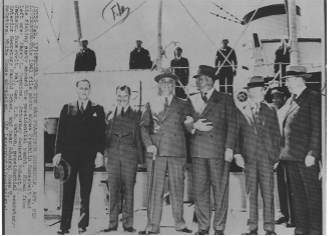

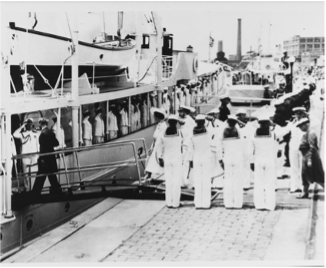
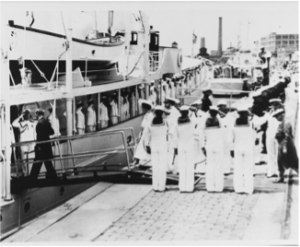 It was “bloody hot” on June 9, 1939, when the King and Queen boarded the USS Potomac at the Navy Gun Factory pier in Washington to a 21-gun salute and the welcome of President Franklin D. Roosevelt and First Lady Eleanor Roosevelt. The King brought on board his own five-gallon container of water from England (you can never be too sure).
It was “bloody hot” on June 9, 1939, when the King and Queen boarded the USS Potomac at the Navy Gun Factory pier in Washington to a 21-gun salute and the welcome of President Franklin D. Roosevelt and First Lady Eleanor Roosevelt. The King brought on board his own five-gallon container of water from England (you can never be too sure).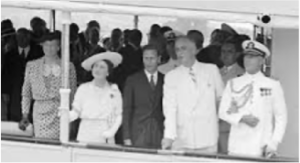 The Royal visit by the Presidential Yacht to Mount Vernon was only possible because a few months earlier, FDR had arranged for the river to be dredged and marked to afford safe navigational access to the Mount Vernon wharf. Today’s navigation dredging projects can take more than 20 years.
The Royal visit by the Presidential Yacht to Mount Vernon was only possible because a few months earlier, FDR had arranged for the river to be dredged and marked to afford safe navigational access to the Mount Vernon wharf. Today’s navigation dredging projects can take more than 20 years.